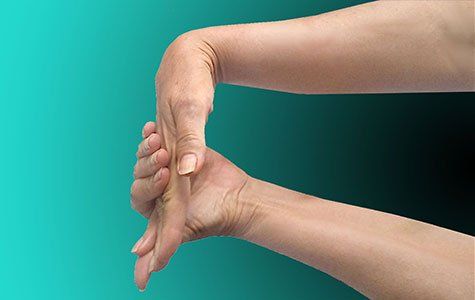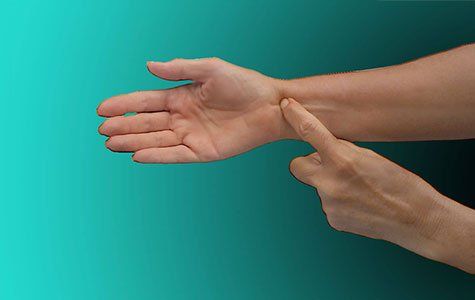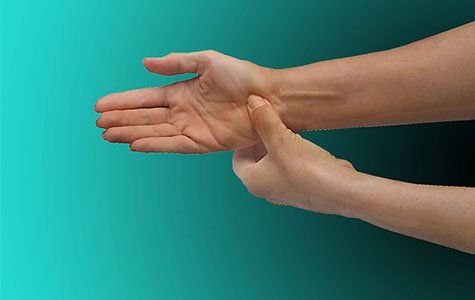Perform this Simple Carpal Tunnel Test
You can do this simple carpal tunnel test on yourself. It will tell if you have carpal tunnel syndrome. If it's not carpal tunnel, it can tell if you have wrist flexor tendonitis.
This is the same test your doctor would give you in their office.
The symptoms and warning signs of carpal tunnel syndrome and tendonitis are almost identical. They include finger or
hand
numbness, pain, tingling, burning, soreness and
weakness.
The following carpal tunnel test is easy to do and only takes minutes. Moreover, it can help you identify if you have carpal tunnel or tendonitis so you can begin treatment immediately.
Are carpal tunnel & tendonitis the same?
The conditions known as carpal tunnel syndrome and wrist flexor tendonitis share symptoms. But they're different disorders.
Wrist
tendonitis is a kind of
Repetitive Stress Injury. That means that overworking your hands and fingers causes the problem. Tendonitis is also relatively easy to treat, The best remedy for tendonitis is simple rest. After a few weeks of not stressing your hand, the tendonitis goes away.
Carpal tunnel syndrome is different. Think of it as a real disease like
diabetes or
arthritis. You can go your whole life and not know you have carpal tunnel syndrome because symptoms may never appear.
It's also a
hereditary condition. That means a family history of carpal tunnel will best predict if you get it or not.
Another factor that can predict if you get it is if you perform regular, repetitive motions of your hand and fingers. This is a key difference between carpal tunnel and tendonitis. With carpal tunnel, repetitive stress doesn't "cause" the condition, it just makes it appear if you already have it.
You are at high risk of getting carpal tunnel syndrome if you have:
- thyroid problems
- rheumatoid arthritis
- kidney disease
If you're a woman, you are at least 3 times more likely to get it. You're at especially high risk if you are:
- pregnant
- taking oral contraceptives
- in menopause
Carpal tunnel test
This carpal tunnel test consists of 3 parts. These are called "provocative tests" because they intend to "provoke" your symptoms. That means they will temporarily make symptoms worse - but only for the few seconds of the test.
Each part is a separate test by itself.
Doctors use these tests in their office to tell if you have carpal tunnel syndrome or tendonitis. If fact, studies show they're more reliable than any other test you can have, including
EMG tests.
You're POSITIVE for carpal tunnel if you answer "YES" to the First, Second or Third test below.
FIRST carpal tunnel test
SECOND carpal tunnel test
THIRD carpal tunnel test
Did you answer "NO" to all of the above questions? If so, the carpal tunnel test shows you might have wrist tendonitis.
Then try the following "Wrist Tendonitis Test".
Wrist tendonitis test
You're POSITIVE for wrist tendonitis if you answer "YES" to the following test question.
Tendonitis test
Now what?
By themselves, each carpal tunnel test above is quite accurate in detecting this condition. When all 3 are positive, you can bet you have carpal tunnel syndrome. The tests also distinguish between carpal tunnel and wrist tendonitis.
If your carpal tunnel test indicates you have either carpal tunnel syndrome or wrist tendonitis, your next step should be to seek treatment. Both conditions are treated effectively using rest, night bracing,
stretching exercises, and
myofascial release massage therapy .
Wrist tendonitis is easier to treat, usually requiring only simple rest. Carpal tunnel syndrome is harder to treat in the mild stage. But if it's in the
severe stage, it's much more challenging to treat effectively.
Summary
In the office, your doctor will give you the identical carpal tunnel test above. Each part alone is very accurate in determining if you have carpal tunnel syndrome. Taken together, the three tests are over 90% accurate. They also can distinguish between carpal tunnel syndrome and wrist flexor tendonitis. Knowing which condition you have is necessary to get the right treatment.
Legal Notification: The above carpal tunnel test is not intended to be a diagnosis. Only your doctor can can do that for you.







